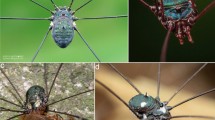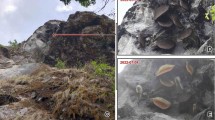Abstract
A new monotypic genus Colisyringophilus n. g. is established for C. tanzanicus n. sp., quill mites parasitising two mouse bird species from Tanzania, Colius striatus Gmelin and Urocolius macrourus (Linnaeus). This new genus is closely related to Neoaulobia Fain, Bochkov & Mironov, 2000, but differs from it by the following features: the stylophore is rounded posteriorly, the propodonotal shield is reduced to triangular sclerite bearing bases of setae vi and ve, the hysteronotal shield is absent, legs I are longer than legs II, and apodemes I are distinctly elongated. This is the first record of syringophilid mites from hosts of the order Coliiformes.


Similar content being viewed by others
References
Chubb, A. L. (2004). New nuclear evidence for the oldest divergence among neognath birds: the phylogenetic utility of ZENK (I). Molecular Phylogenetics and Evolution, 30, 140–151.
Clements, J. F., Schulenberg, T. S., Iliff, M. J., Sullivan, B. L., Wood, C. L., & Roberson, D. (2012). The eBird/Clements checklist of birds of the world: Version 6.7. The Cornell Lab Ornithology, Ithaca, New York [Available online at http://www.birds.cornell.edu/clementschecklist/downloadable-clements-checklist]. [Verified 3 January 2013].
Cracraft, J. (1981). Toward a phylogenetic classification of the recent birds of the World (Class Aves). The Auk, 98, 681–714.
Espinosa de los Monteros, A. (2000). Higher-level phylogeny of Trogoniformes. Molecular Phylogenetics and Evolution, 14, 20–34.
Grandjean, F. (1939). Les segments postlarvaires de l’hysterosoma chez les oribates (Acariens). Bulletin de la Société Zoologique de France, 64, 273–284.
Grandjean, F. (1944). Observations sur les acariens de la famille Stigmaedae. Archives des Sciences Physiques et Naturelles, 26, 103–131.
Hackett, S. J., Kimball, R. T., Reddy, S., Bowie, R. C. K., Braun, E. L., Braun, M. J., Chojnowski, J. L., Cox, W. A. et al. (2008). A phylogenomic study of birds reveals their evolutionary history. Science, 320, 1,763–1,768.
Johansson, U. S., Parsons, T. J., Irestedt, M., & Ericson, P. G. P. (2001). Clades within the ‘higher land birds’, evaluated by nuclear DNA sequences. Journal of Zoological Systematics and Evolutionary Research, 39, 37–51.
Kethley, J. B. (1970). A revision of the family Syringophilidae (Prostigmata: Acarina). Contributions of the American Entomological Institute, 6, 1–76.
Kethley, J. B. (1971). Population regulation in quill mites (Acarina: Syringophilidae). Ecology, 52, 1,113–1,118.
Kethley, J. B. (1990). Acarina: Prostigmata Actinedida. In: Dindal, D. L. (Ed.), Soil biology guide. New York: Wiley and Sons, pp. 667–754.
Livezey, B. C., & Zusi, R. L. (2007). Higher-order phylogeny of modern birds (Theropoda, Aves: Neornithes) based on comparative anatomy. II. Analysis and discussion. Zoological Journal of the Linnean Society, 149, 1–95.
Mayr, G. (2005a). The postcranial osteology and phylogenetic position of the middle Eocene Messelastur gratulator Peters, 1994 – a morphological link between owls (Strigiformes) and ‘falconiform’ birds? Journal of Vertebrate Palaeontology, 25, 635–645.
Mayr, G. (2005b). The Paleogene Old World potoo Paraprefica Mayr, 1999 (Aves, Nyctibiidae): its osteology and affinities to the New World Preficinae Olson, 1987. Journal of Systematic Palaeontology, 3, 359–370.
Skoracki, M. (2011). Quill mites (Acari: Syringophilidae) of the Palaearctic region. Zootaxa, 2840, 1–415.
Skoracki, M., Zabludovskaya, S., & Bochkov, A. V. (2012). A review of Prostigmata (Acariformes: Trombidiformes) permanently associated with birds. Acarina, 20, 67–107.
Sorenson, M. D., O’Neal, E., García-Moreno, J., & Mindell, D. P. (2003). More taxa, more characters: the hoatzin problem is still unresolved. Molecular Biology and Evolution, 20, 1,484–1,499.
Van Tuinen, M., Sibley, C. G., & Hedges, S. B. (2000). The early history of modern birds inferred from DNA sequences of nuclear and mitochondrial ribosomal genes. Molecular Biology and Evolution, 17, 451–457.
Acknowledgements
Special thanks are due to Prof. Gerhard Haszprunar (Director of the ZSM) for making the samples of bird skins available for the present study. The authors are obliged to the two referees for their critical comments and remarks.
Author information
Authors and Affiliations
Corresponding author
Rights and permissions
About this article
Cite this article
Skoracki, M., Unsoeld, M. & Ozminski, M. A new genus of quill mites of the family Syringophilidae (Acari: Cheyletoidea) associated with mousebirds (Aves: Coliiformes). Syst Parasitol 85, 213–217 (2013). https://doi.org/10.1007/s11230-013-9427-6
Received:
Accepted:
Published:
Issue Date:
DOI: https://doi.org/10.1007/s11230-013-9427-6




